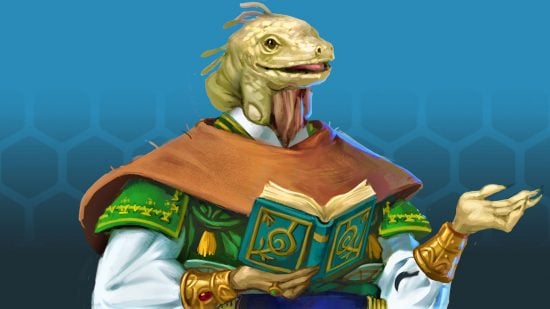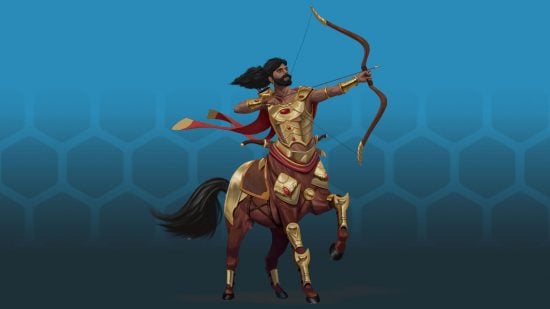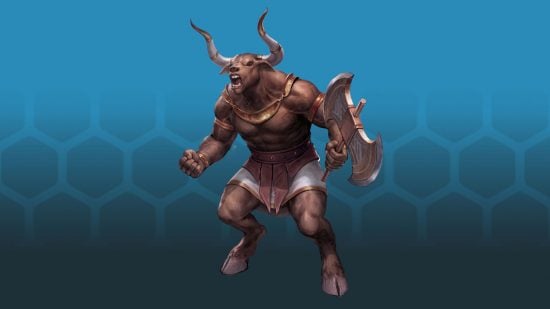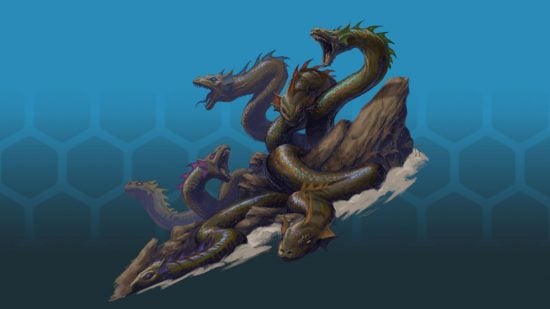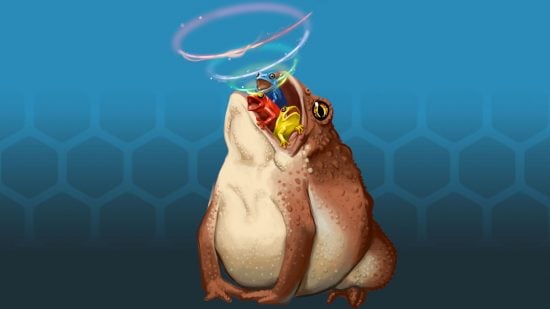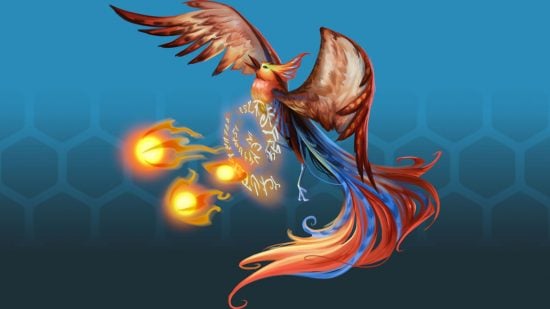Pathfinder’s newly announced book, Howl of the Wild, focuses on all that’s weird and wonderful about the natural world. Revealed on May 12, the Pathfinder 2e book is one part bestiary and one-part adventure novel. It follows a keen naturalist and his eccentric crew as they explore and document the world of Golarion, David Attenborough style. The Paizo team has pulled out all its weirdest animal facts to put this one together.
We spoke to senior designer and project lead James Case about what to expect from Howl of the Wild, and we made plenty of new discoveries. Wargamer can exclusively reveal the Centaur and the Minotaur, two of the six new Pathfinder races in Howl of the Wild. Here you’ll also find a first look at the colourful creatures inside the sourcebook, as well as the equally vibrant characters who’ll guide players through the sea of fresh content.
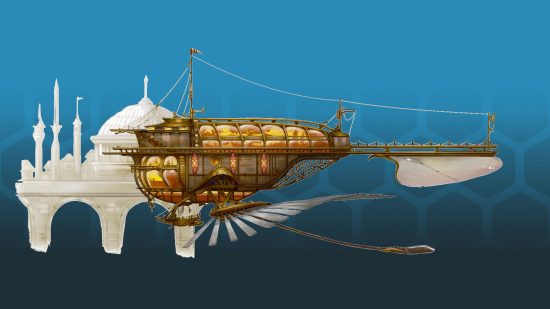
WG: Can you give me an overview of Howl of the Wild?
JC: Howl of the Wild is a book of creatures where we’re going really deep into all things, animals, beasts, and nature. It’s a nature documentary slash adventure novel focused on an old naturalist, who maybe wasn’t the most adventurous sort as a kid. Now he’s off exploring the world alongside this odd crew on their ship, the Zoetrope. They basically go around the world of Golarion researching various creatures, meeting various societies, and ultimately seeking four Mythical Beasts called the Wardens of the Wilds, which the naturalist remembers from a bedtime story.
Throughout the book, we’re going to be giving you a whole bunch of new animals and beasts. That’ll be everything from expansions on classic monster types, like hydras and manticores, to totally new inventions. A lot of these are inspired by real-life creatures that might be a little unusual.
Howl of the Wild is also going to have a tonne of player options, whether that’s items that can be used in the wild or have ties to animals, or whether that’s one of the six new ancestries we’re introducing in this book – each one of which has a bit of a sort of more animal bent to it. There’s also our general list of spells, feats, archetypes – all that good stuff.
What can you tell me about the new playable character options?
We have six new playable ancestries in Howl of the Wild, and we’re going to announce two of them right here. Both are from classical mythology, and both are things people have been asking for for a long time.
The first one is the Centaur. These have been in our setting for a while. They’re from the continent of Casmaron, but they’re nomadic (as you might expect from people that are part horse). This means they’ve spread across much of Golarion.
This is a cool ancestry that lifts a lot from classical mythology while adding its own spin. It’s no surprise that, for example, their character builds capitalise on their speed. They’re also experts at herbalism, and they have connections to primal and divine magic.
Another ancestry in the mythology vein is our Minotaur. They’re from Iblydos, which is an archipelago that’s inspired by Greek mythology (among other things). They have this mythical past where they didn’t have the best interactions with some of the old hero gods – this may or may not be true, but it’s part of their lore.
Minotaurs are big and strong, but they’re also used to living in mazes, so they have an appreciation for architecture and stone work. I think there’s a little bit of fun text [in the book] that mentions their settlements have more buildings than they necessarily need, because they see making the buildings as an art as part of their architecture. Because they have these mythical associations with hero gods in their origin, Minotaurs have some interaction with divine magic too.
The art here shows a Minotaur Barbarian. This is a classic build people might think of first, and the ancestry has a lot of abilities that reinforce Minotaurs are strong creatures. However, they also have abilities with stone magic and engineering.
They’re very good at puzzles, I imagine.
Oh, yeah. They had a fair bit of lore from first edition, and one of the bits we found ourselves going back to is that some Minotaurs construct physical labyrinths, while others construct mental labyrinths. This means secrets, political intrigue, and that kind of thing. So there are a lot of ways to take the Minotaur concept.
You’ll see this when you meet the Zoetrope’s Minotaur crew member – she’s a lot of fun. Each of the crew members is a member of one of the six new ancestries. We thought that, as well as stats and character builds, meeting a member of each ancestry and really getting to know their personalities might be a fun new way to introduce them.
What can you tell me about the new creatures we’ll encounter in Howl of the Wild?
Before we start, I think it’s really important to note this book is quite a ways off, so we can only go through so much. That being said, let’s start with the Hydra.
This is something we’re tentatively calling a Prism Hydra. The Hydra is a large multi-headed snake, a classic serpent from mythology, and its signature ability is that it can regenerate. The Prism Hydra is a variant of this. It’s a byproduct of magical experimentation in our setting, which has unfortunately given it new abilities.
Each one of its heads has associations with different energy types and can shift in and out of each. Whereas with a normal Hydra, you can stop it from regenerating by burning or cauterising the stumps [of decapitated heads], this one is a lot more difficult to deal with as each of the heads is constantly changing abilities.
I really like the art here. One thing we wanted to explore is the way real-life animals are awesome, and I think here the artists looked at the colouration on iridescent birds and insects. I think the artists did a great job on this.
Another creature we want to show off is our Concert Frog. A lot of the entries in this book go back and explore basic monster types and expand on them – so we have more sharks and more dinosaurs, and this is one of our new frogs.
This is based a little bit on mouth-brooding frogs that keep their young in their mouths. The Concert Frog is a large frog with little froglets in its mouth, and they harmonise to create songs that create various effects. The songs might have effects on the players, or they might help the Concert Frog get away from predators.
Concert Frog is adorable, and I think I’d want to be its friend.
Animal companions and familiars are a big part of this. It’s no secret to say our animal book might have some options for new animals you can train and act alongside.
What about the last creature, the Spellsong Lyrebird?
This is another example of us exploring the wondrous things animals can do in real life. Actual Lyrebirds can imitate a wide variety of sounds, everything from other birds to the sound of construction equipment. The Spellsong Lyrebird is very intelligent, and it’s learned to imitate other sounds – which has unfortunately included the incantations of nearby Pathfinder Wizards. This is essentially a bird that has learned how to spell cast.
In first edition, animals were kind of a basic creature type. They could attack, they could pounce, or they could rend. But they didn’t have many advanced tactics. One of the cool things I think this shows off about Pathfinder 2e is that ‘normal’ animals can do lots of really bizarre things.
It sounds like the team is going to come out of this book with an encyclopaedia of very weird and wonderful animal facts.
That’s probably one of the goals here. There were definitely lots of weird animal clips being shared in the writers’ server – and a lot of David Attenborough in there.
What’s the weirdest creature you’ve created for Howl of the Wild?
One fun creature we have coming up is a small creature that isn’t evil and doesn’t mean ill, but it eats gold. Naturally, players don’t tend to like it when their gold gets eaten. It’s a great example of a creature that’s quite cute and isn’t acting out of malice, but it might be a problem for players to interact with. There are definitely other creatures that aren’t combatants. For example, there’s one creature whose primary role is public transit.
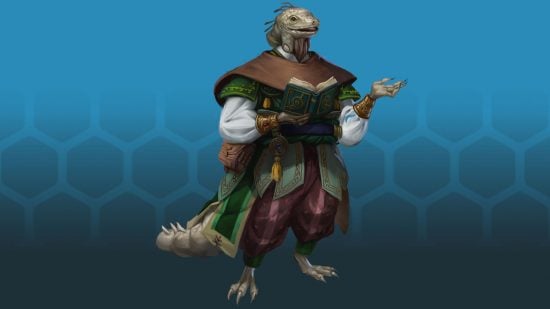
Howl of the Wild seems like a book filled with a lot of colour, right?
The Wilds is a vibrant place, whether you’re in its mountains, deserts, or somewhere underground. The framing device here is the Wardens of the Wild, these four great beasts that are rumoured to steward over various great biomes. We have the Warden of Peaks and Skies, the Warden of Oceans and Rivers, the Warden of Forests and Meadows, and the Warden of Caverns and Depths. Having this narrative framing device is one thing I and lead designer Logan Bonner have been really excited about.
Can you tell me more about the narrative aspect of Howl of the Wild?
The tone we wanted to go for was that nature isn’t a scary place to be, but rather a place full of wonders to explore. So we’re seeing it all through the lens of a character who’s a bit older, who maybe wanted more adventure in his youth but life got in the way. He’s a little timid, and he’s not in the best adventuring shape, but he’s finally going out to find something that’s been his life’s dream.
This is our naturalist; his name is Baranthet, and he’s from Garun, which is a Lizardfolk nation of dinosaurs and swamps. You’ll see him and his airship, the Zoetrope, as well as his six eccentric crew members. They’ll offer their comments on some of the book’s monsters or let us know we’re in a new area. Each of the crew members was taken on by a different author, so each brought a really cool, different voice to it. The crew and the ship itself were all created in-house by our concept artist Kent Hamilton.
You can learn more about Howl of the Wild in Paizo’s announcement post. While we don’t know exactly when Howl of the Wild will release, we can expect to see the book drop sometime in 2024. Before then, Paizo says it’ll have more to share on the book at Paizo Con Online 2023.
